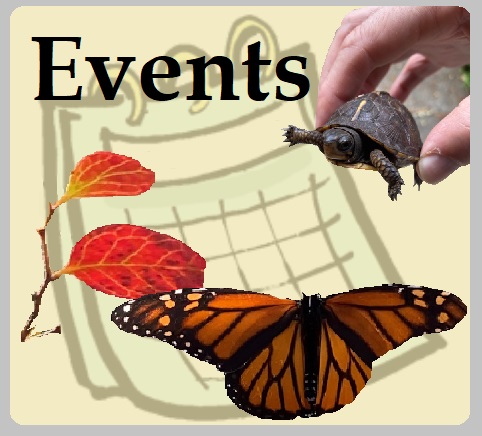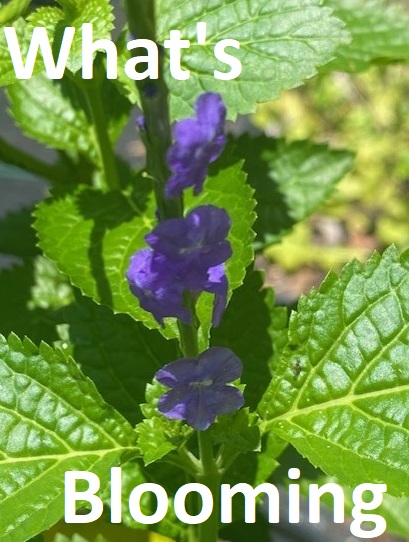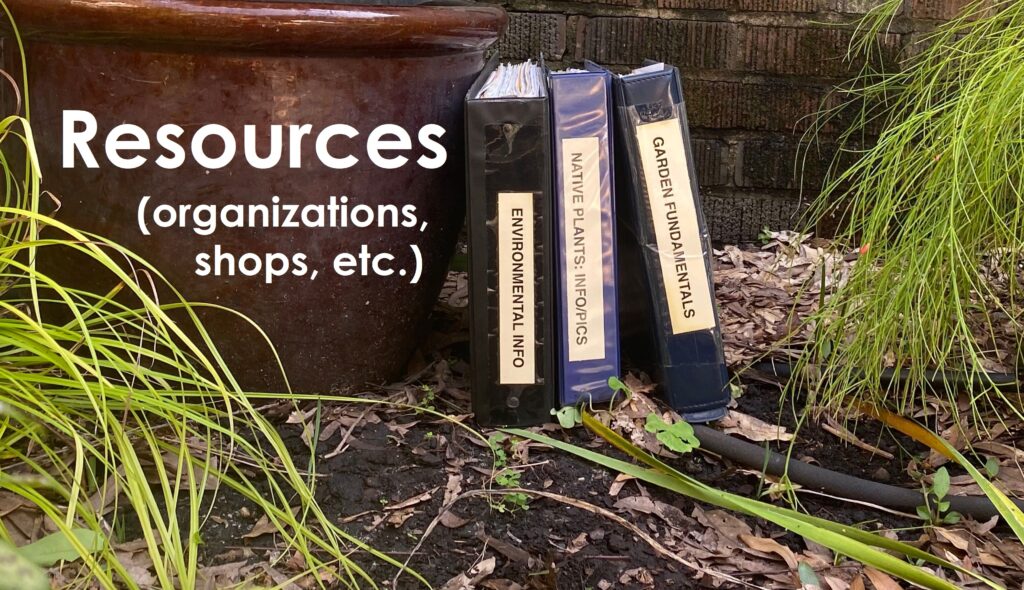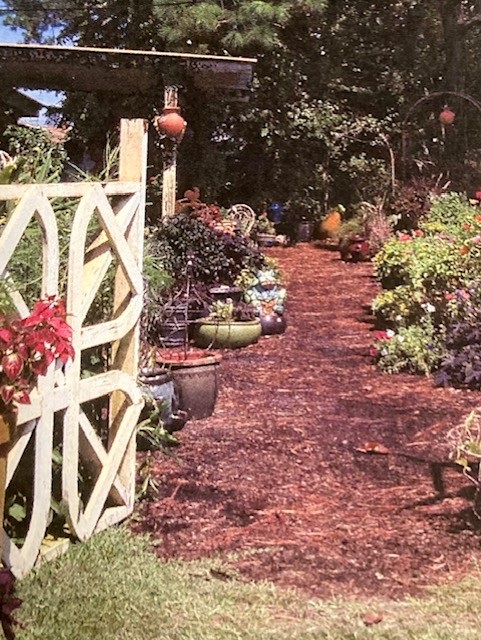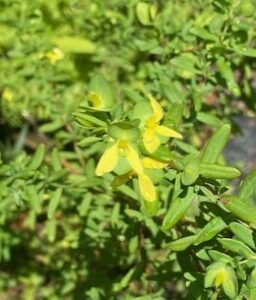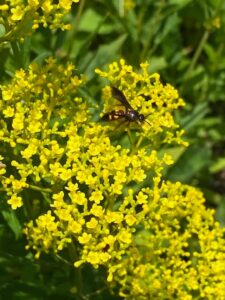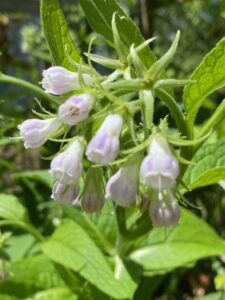Beyond the Garden Gate
Most Recent Posts
August 20, 2025St. Andrew’s Cross
Hypericum hypericoides
Red Basil (Red Calamint)
Clinopodium coccineum
Yellow-berried Holly
Ilex aquifolium ‘Bacciflava’
Porterweed
Stachytarpheta cayennensis […]
Read more…
August 13, 2025Insects and lizards actually enjoyed the astonishing heat wave of last month. The lizard population has grown exponentially — this week there is a whole new crop of baby anoles (or chameleons), both green and brown. The brown anoles, or Cuban anoles, are a non-native species introduced from the Caribbean. While there is some controversy about their presence in our landscapes, the two species seem to co-exist. At least there are both in my garden. Both are insect predators, and each species seems to stick to a territory or a layer.
Anoles lay white eggs (usually one at a time) about a 1/4” long. They look like tiny chicken eggs. We often found the eggs barely buried or covered, in a pot or other hiding place. The just-hatched lizards are tiny, but active from hatching. The anoles, both green and brown, are workhorses in the garden, always on the hunt, eating insects and keeping pest populations at bay. Right now, there are a lot of insects for a lizard feast, since insect populations increase rapidly in the heat. Lizards do an amazing job.
I’m sure those of you that know me will not be surprised that I “talk” to lizards. I love to talk to lizards because they seem to listen. They stand their ground and turn their head, like they are listening intently to what I say. That always makes me smile.
Actually, I talk to anything in front of me—plants and flowers, insects and reptiles, amphibians and mammals. It seems polite to acknowledge and appreciate the gifts each species brings to the garden. Naming the garden inhabitants is fun to do with children. Something about personalizing each plant or animal lets us see them from a different and more valuable perspective.
This summer, the mealy bugs have been prolific, covering plants with what looks like a mushy white “goo”. Mealy bugs are a pest insect that multiply quickly, covering the stems and leaves of a perennial almost overnight. Natural predators include lizards, lacewings and ladybugs, among others. White flies and aphids are also building pest populations. What we so often forget is that we don’t get the beneficial insects until the pest insects show up.
Mealy bugs are pretty easy to control. You can easily “squish” the mealy bugs by moving your fingers down the plant stem. Another way to control mealy bugs, white flies, aphids, and other soft-bodied insects is with soapy water. Soap acts as a desiccant, and dries out the insect bodies. Like any other substance, even mild dish soap should be used with care. Soap can dry out the plant if too much is used. It is a good idea to rinse the plant later in the day, if soap spray is used.
One of the most interesting pollinators that is active now is the leaf-cutter bee. A small black and yellow bee, it literally cuts leaves in a circle, choosing supple leaves to harvest. The leaf circles are folded into tube-like round chambers. Each leaf chamber holds a bee larva with pollen to feed it until maturity. Each of the larva chambers are stacked into tubes containing several chambers. The tubes are usually hidden in loose soil or leaf mulch. I have found the tubes in bags of mulch. The intricacy of the larva chambers is amazing.
Yellow seems to be the predominant flower color in the garden right now — black-eyed Susans, dune sunflower, Patrina are all at peak bloom this month. Yellow flowers attract butterflies, bees, and other pollinators that are active in the summer. Most of these yellow flowers are daisy-shaped, making it easy for butterflies to land and feed, rather than having to expend extra energy flying and eating at the same time. Some of you might not be familiar with Patrina. This long-blooming perennial has lacy yellow flowers. The long blooming flowers are always covered with pollinating insects. Sometimes there will be as many as five species nectaring at the same time.
Purple and lavender flowers are blooming or are just about to open. Tibochina ssp., (princess flower), are some of the most spectacular purple flowers blooming against pale green fuzzy leaves. Even the dwarf tibochina gets large — up to 4’, and other species get taller. The most spectacular is the big-leaf tibochina. Large fuzzy leaves, big clusters of bright purple flowers on a big plant — this plant is a focal point in the fall garden.
And then, there’s the horsemint! I love horsemint, and it attracts many pollinators. Horsemint is a native species of bee balm (Monarda punctata) with “stacked” flowers of lavender and pink, off-white with a few dots. The colors are subtle, but the “show” of busy insects is amazing! However, horsemint re-seeds with abandon! I have pulled up many horsemint plants this year, but you would never know it to look at my yard. My mission now is to let the pollinators collect all the nectar from the flowers, then I will pull the majority of the plants before they set seed. I have a feeling I have already lost this challenge.
More and more red flowers will begin to bloom over the next few weeks. That will coincide with the fall hummingbird migration — red is their “go-to” color. Red basil (or red calamint) (Calamentha coccinea) is a small evergreen shrub native to well-drained soil (the beach and the Gulf Breeze peninsula) with bright red trumpet-shaped flowers in the late summer and fall. Red basil does very well in my Pensacola yard, in a section that gets no irrigation. It brightens up the mostly shady area. Fire Spike is another hummingbird favorite that blooms in fall. Fire Spike is a tropical-looking perennial with large leaves and as the name implies, has tall spikes of red flowers all fall. Fire Spike will grow in sun or shade and is generally hardy. It will die back in winter but return in spring.
There are other signs of fall. The Mississippi kites that return every year to my neighborhood to mate and hatch chicks are preparing for their fall migration. The chicks have hatched and matured. I hear their beautiful call throughout the day, and watch these acrobatic birds soaring overhead. Soon the kites will migrate to their winter habitat, and they will be missed. But other birds will appear.
The hollies, sparkle berry, and beauty berry are loaded with berries, awaiting the arrival of the cool season migrating birds. The beauty berry is already beginning to change from green to the brilliant purple berries of fall. Acorns and hickory nuts are forming for other birds and wildlife to feed on over the winter. All we need now is cool weather!
In the veggie garden my field peas are really loving this heat and so is the okra. Both are growing and producing as fast as I can pick them. By the way, black-eyed peas and zipper peas (the two varieties of field peas I am growing this summer) make excellent hummus.
Black-eyed pea hummus: Boil the peas (1.5 c) until soft, and cool. Place in a food processor or blender, and process until smooth. Add 1/3 c. Tahini, 2 Tbs. olive oil, 2 Tbs. lemon juice, 1 garlic clove. Blend, adding up to 5 Tbs. water until the consistency is smooth. If desired, top with red pepper, pine nuts or chopped pecans, or toppings of your choice.
I recently bought three unique plant stands at a neighborhood garage sale. These plant stands were made in Japan to display bonsai specimens. They were brought to Pensacola by former Naval officers, and now reside in my yard. I have the perfect use for them! My strawberry plants are always trying to escape from their raised bed. Actually, that is a good thing — the “escapees’ are new plants sent out from the parent as “runners”. These plant stands will allow the runners to trail downward. I love the look of that, but it has a practical purpose too. Strawberries are beloved by slugs. But slugs don’t like to cross metal screen with the metal strands exposed. I understand that they are particularly sensitive to copper screen, because the copper produces a tiny current. I can put metal screening underneath the planter and the pot. I will let you know if this plan works to keep slugs away. I have the feeling that whether or not this anti-slug plan works, the birds will be feasting!
There are other great reasons to grow plants in containers throughout the garden. Containers and the plants in them can make an instant focal point, drawing the eye to an otherwise uninteresting area. Taller plants in containers can give instant privacy, or soften a landscape. Containers can keep plants that are aggressive spreaders in check. Passion vine and other vines are examples, as are some ground covers.
For example, I grow horsetail rush (Equisetum ssp.) in a large low pot, to keep them from spreading around the yard. This plant was given the name “horsetail” because the reed-like plant is segmented like the bones in a horse’s tail. Horsetail rush is an ancient plant that has existed on earth for 400 million years, and still grows on five continents.
This picture has potted horsetail in Tokyo, Japan.
Horsetails are such ancient species, they evolved before flowers existed and, like ferns, reproduce by spores. Usually found along stream banks, horsetail reeds have silica in their stems. Historically, people used the scratchy stems to scour dishes, — “scouring rush” is another common name for horsetails. These days, I like to cut horsetails for interesting arrangements, both fresh and dry. The green stems turn a beautiful ochre color when dried, and last for years.
Not long ago, I came across that same pattern on the shell of a young box turtle in my yard. The “spine” of the shell has an ochre stripe with black “dashes” in regular intervals. It perfectly mimicked the dried horsetail rush in my sitting room. The patterns on the other scutes looked like stylized artwork — simplified patterns like a beautiful batik fabric. Other ochre markings on the dark brown of the shell make it look like it is lit from within.
Turtles are also ancient species, on Earth before dinosaurs. They would have been likely to live in swamps or wetlands where the horsetail rush grew in abundance. I wonder if box turtles might have this coloration and pattern as a camouflage. The turtles would have perfectly blended in such an environment.
Nature’s “coloration” is so purposeful: to camouflage or blend in, or bright colors to attract a mate, dangerous looking eye-spots or “horns”; twig-like bodies to hide in plain sight! Every species is perfectly adapted to fit in its environment. The list is endless, and I never tire of looking for each unique species. I hope that you all have as much fun in your gardens as I do!
We have several events planned for next month. We are planning a garden tour of a Pensacola yard that is planted as a “food forest”. The date for this tour has not yet been set. We will be participating at the Horticultural / Environmental Seminar, presented by the Navarre Garden Club on Sept. 8th at the Navarre Welcome Center. More details will follow on this event too. On Sept. 10th, we will be presenting at the Hoe and Hum Garden Club at St. Francis Church in Gulf Breeze at 10am. The topic will be Vines and Ground Covers. Hope you will join us! […]
Read more…
July 15, 2025Patrina
Patrina scabiosifolia
Alligator lily
Hymenocallis latafolia
Fennell
Foeniculum vulgare
Ironweed
Vernonia augustifolia […]
Read more…
July 11, 2025Wet or dry? It seems like we are in a wet stage right now, but who knows what the weather will be like next week. Many gardeners have issues with yards that are too wet — flooding, runoff from other structures, water pooling in spots in the yard, or rainwater that causes erosion on a slope. “Nature” would like to make some suggestions!
One of the most beautiful solutions to sloping gardens is a “dry” streambed. Dry streambeds give the illusion of a creek winding through the landscape, but the “streambed” can channel over-flow to a drain, or a wetland. Or the dry streambed might meander across a slope to slow erosion.
Grasses play more than one role in a dry streambed. Grasses are nature’s erosion control. The root system of grasses is very fibrous and dense to hold soil in place. (Think sea oats on the beach — they hold the soil and catch the sand to create more land.) Grasses not only hold soil in place, but they can make a landscape come to life with their movement in a breeze. Grasses planted in drifts along a shallow, slightly curved channel, with small shrubs and ground covers, can give the impression of moving water. Punctuated with flowers or textures, a dry streambed makes a beautiful landscape feature.
If you have flooding or pooling water in your landscape, a rain garden can catch and hold excess rainwater until it is absorbed by trees and other plants, or has evaporated. A rain garden is basically a depression that acts as small-scale wetland. Rain gardens can also make a beautiful focal point in your landscape.
Many of our most beautiful native plants thrive in boggy or wetland conditions. Over the years that I have been gardening, I have dug several bog gardens, because I love the wetland plants. There were actually two bog gardens at The Garden Gate. These gardens were designed to hold water in a dry area. About 18” of soil was removed from the area, which was then lined with plastic. Holes were punched in the plastic to slow the drainage. The soil was then replaced in the area with some peat moss and mushroom compost. This garden stayed moist enough to grow the bog plants.
This summer, I’ve been “re-doing” the garden around my pond. It isn’t a large area, but it is a favorite view from inside the house, and a favorite place to sit outside. I love the sound of the water from the fountain, and I love to watch all the life the water brings to the garden. It seems like I have a greater variety of birds that visit the pond than at bird feeders.
The pond area is tucked into a corner where two walls of the house meet in an “L” shape, so I am enclosing the other two sides with a fence, for privacy and to create habitat. There’s no gutter along the walls in this area, so the soil along the drip line is wet after rain. This narrow area is usually wetter than the surrounding beds — wetland plants thrive there, and they are a perfect background for my pond. In this damp area, so far I’ve planted two species of native hibiscus, Louisiana iris (several different colors), Joe Pye Weed, star sedge, rain lilies, Chippola coreopsis, ironweed, a swamp clematis (or leather flower), and a climbing aster.
The native hibiscus that I planted are two of our most beautiful native hibiscus species — Scarlet Hibiscus (Hibiscus coccinea) has huge star-shaped red flowers, and Swamp Hibiscus (Hibiscus grandiflorus) has velvet-like blue-green leaves, with a huge pink flower. Both of these plants can grow to 6’ tall in a wet area, but will be about half that height in drier soil. Both die back in the winter, but return in the spring with more stalks. These hibiscus can grow in wet soil, but can also tolerate drier soil.
In fact, most of the plants listed will grow in dry areas, but may need supplemental irrigation. (That makes them perfect for a garden that is usually dry but occasionally floods, like a rain garden.)
The other two sides of my pond area are dry, so the plants in those areas are planted to attract butterflies and other pollinators. This is also a very narrow area, so the plants must grow upright. Vines can really soften and enclose an area. I have used two types of passion vine: yellow passion vine and “Incense” passion vine. Both host the Gulf Fritillary butterfly and the zebra longwing butterfly. A word of caution about these vines: they are very aggressive spreaders. Having learned the hard way (not all neighbors appreciate these plants!), I grow them in containers and put a concrete stepping stone underneath.
Other host plants in that garden are fennel and parsley for Eastern black swallowtail; milkweed for monarchs; native ruellia, firecracker, and frog fruit for buckeyes; and rabbit tobacco for American painted ladies.
Rabbit tobacco is a native annual (sometimes biennial) that re-seeds freely. The thin leaves are green on the top and silver underneath. This fragrant plant has been used as a tobacco substitute, but it was also used medicinally to treat respiratory illnesses. Sometimes it is referred to as “everlasting” because the fall blooming flowers keep their form and color for many years when dried. (The flowers are great to use on wreaths and in arrangements). The silvery foliage is a great contrast and texture in the garden, but I like to grow it to attract the painted lady butterflies.
Painted ladies are medium-sized butterflies with beautiful markings. They are more prevalent here in the early spring and in the fall. I was delighted to find caterpillars (many caterpillars!) on my plants a few weeks ago. The adult female lays her eggs on the newest leaves at the top of the rabbit tobacco. When the eggs hatch, the caterpillar uses silk to “glue” the leaves around him as he eats and grows. Any time you notice a rabbit tobacco plant with what looks like a wilted top, there might very well be a caterpillar inside!
Nectar plants in my dry sunny space (so far!) include Mexican sunflower (tithonia), bee balm, indigo spires salvia, and dune sunflower. Another one of my favorite silver pollinator plants is mountain mint. This native mint family member is pretty unremarkable — until it blooms. In warm weather this evergreen perennial begins to grow taller with several stems. The top of the stems produce “silvery” flowers this time of year. The flowers are actually tiny, but they are surrounded by silver bracts, or modified leaves.
As the name implies, mountain mint is a member of the mint family. A useful bit of information for identification purposes: plants in the mint family have square stems. But that might not help much since this large plant family has around 180 genera, and no telling how many plants are included in each genus! Square stems might not do much to narrow down the species ID.
Many of our favorite blooming plants are classified in the mint family. For example, salvias and Monarda (bee balm) are included in this family. Many salvias, bee balms, and other mint family members grow well here, but not all. Some will mildew in our humidity, or don’t bloom. Bee balms that grow well for us are: Wild bergamot (Monarda fistulosa), a perennial with pink to lavender flowers; Lemon bee balm (Monarda citridora), an annual with a lemon scent and stacked lavender flowers; and Horsemint or Dotted bee balm (Monarda punctata), perennial that also freely re-seeds. And I mean FREELY! But horsemint also attracts an astounding number of pollinators. Maybe it reproduces so freely because it feeds so many pollinators..?
If your landscape is dry or well-drained, choosing the right plants will make a big difference to your garden’s success. Native plants that naturally grow in our dry areas are a good choice. Not only are they adapted to our growing conditions (needing less water and fertilization), natives also already have established relationships with pollinators and local wildlife.
If you have an irrigation system, plants with the same water requirements should be planted in the same area, adjusting each zone to gets the water needed. Watering early in the morning will allow the water to get to the roots before evaporating in the heat of the day. Just before dawn is best as watering overnight can sometimes lead to fungus diseases on wet foliage.
Water is taken up by the plant roots, and released by the foliage. If you are watering by hand, water only the soil. Excess water on the leaves can actually burn the leaves if magnified by the sun. Soil temperature plays a large role in the amount of water necessary— plants that provide shade lessen the amount of water required.
Out in the vegetable garden, the okra is blooming and the zipper peas are growing nicely. The rattlesnake beans typically produce about three days after a rain. I’ve gotten a pretty good crop since it has been raining a good bit. The cucumbers are still producing but they seem to be winding down. I will plant another crop for the late summer and fall. Blackberries are over for the season, but they too, often produce in the fall.
In a big galvanized tub in the vegetable garden, I grow Jerusalem artichokes. This plant, sometimes called “sun chokes” is actually a sunflower (Helianthus tuberous). Historically, Jerusalem artichokes were an important native food source. The bright yellow blooms make a lovely addition to a garden, although this plant tends to spread quickly by birds (hence the galvanized tub). The root produces an edible tuber that resembles the taste of an artichoke. While tasty, this tuber can also cause flatulence, so beware.
The blueberries produced a bumper crop and the green figs outdid themselves this year. The fig crop was pretty evenly divided between me and the birds! We ate a lot right off the tree, and had a few left to put in the freezer.
The green figs are so huge, I cut them in half and then stick them in the freezer. No blanching or pre-cooking is needed. They are a delicious snack on a hot day — better than a popsicle! I often do that with chunks of watermelon, too — then take out a piece or two to cool me down on a hot day.
In addition to my figs and blueberries, the birds in my garden are feasting on Coral Honeysuckle berries and Simpson’s Stopper berries right now. The mockingbirds are the chief berry-eaters. Like the flowers on this native honeysuckle, the berries are also bright red. Coral honeysuckle is evergreen and has color of some kind most of the year. Sometimes the wildlife (like hummingbirds) that feed on it provide the color, but there is always something to see.
The Simpson’s Stopper is an evergreen shrub, native to the Florida peninsula, but it seems to do well here. In my garden, the dwarf variety gets to be about 6’-7’. The species can reach 12’ and makes a great screening shrub. Simpson’s Stopper produces many fragrant white flowers in the spring, then red berries in the summer. (By the way, Simpson’s Stopper got the name “Stopper” because it was used medicinally to stop diarrhea. I wonder if it would help with the Jerusalem artichoke?)
Other birds are busy feeding on pest insects. The brown thrashers are very actively feeding on bugs and worms. The pine bark mulch around the pond was disturbed when I re-planted the area, and the thrashers had a feeding frenzy! Brown thrashers are aptly named — they can “thrash” through a mulch or leaf pile, swinging their long slightly curved beak. Who knew that a thrasher could toss a piece of pine bark five feet? Brown thrashers are very beneficial for gardens, plus they have an amazing repertoire of songs. They generally nest in dense shrubs or trees closer to the ground than most other birds, sometimes just two feet high. Since they feed on insects and worms in leaf litter, they are close to the “dinner table”.
We have two events planned for September, when hopefully the weather will be a little cooler. Beyond The Garden Gate will be with the Hoe and Hum Garden Club on Sept. 10, to do a presentation on vines and ground covers — “Ups and Downs in the Garden”. This will be held at St. Francis Episcopal Church in Gulf Breeze at 10 am. We also have plans to tour a local garden and food forest. Details, including the date and time, will be announced. Stay tuned also for the opening of the Ethnobotanical garden at The Archeology Institute at UWF. Meanwhile, stay cool! […]
Read more…
June 17, 2025Comfrey
Symphytum officinale
Native Milkweed
Asclepius perennis
Wax Mallow
Malvaviscus drummondii
Big Leaf Coneflower
Rudbeckia maxima
Jackobina
Justica carnea
Mexican Cigar Plant
Cuphea ignea […]
Read more…
(Click on the images below)

